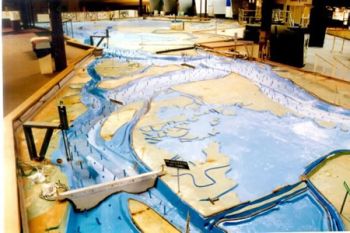Three-Dimensional Hydraulic Models: Difference between revisions
No edit summary |
No edit summary |
||
| Line 12: | Line 12: | ||
|caption= | |caption= | ||
<!-- Add picture caption --> | <!-- Add picture caption --> | ||
The USACE Bay Model is one of the most famous and most complex physical hydraulic models ever built. While it was once used for scientific research, it is now a tourist attraction. ([https://www.spn.usace.army.mil/Missions/Recreation/Bay-Model-Visitor-Center/The-Bay-Model-Journey/Trekking-the-Model-Tour/ USACE]) | The USACE Bay Model is one of the most famous and most complex physical hydraulic models ever built. While it was once used for scientific research, it is now a tourist attraction. | ||
(Image Source: [https://www.spn.usace.army.mil/Missions/Recreation/Bay-Model-Visitor-Center/The-Bay-Model-Journey/Trekking-the-Model-Tour/ USACE]) | |||
}} | }} | ||
Latest revision as of 20:58, 21 July 2023

|
| The USACE Bay Model is one of the most famous and most complex physical hydraulic models ever built. While it was once used for scientific research, it is now a tourist attraction.
(Image Source: USACE) |
Three-dimensional hydraulic models are typically used in the study of rapidly-varied flow that occurs along a spillway or bridge pier or in the study of the effects of turbulence and irregular flow geometries on various closed conduit components such as valves or flow meters. As a result of the uncertainties in predicting the effects of rapidly-varied flow by using either one- or two-dimensional hydraulic modeling methods, three-dimensional models reduce the uncertainty in this type of turbulent flow and help to achieve a greater level of optimization for a hydraulic design in an engineering project. There are two types of three-dimensional hydraulic models that can be used depending on the level of analysis and detail required by the study and available funds:
Citations:
Revision ID: 7425
Revision Date: 07/21/2023
